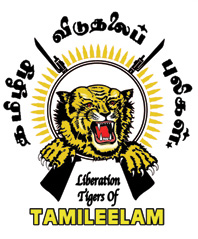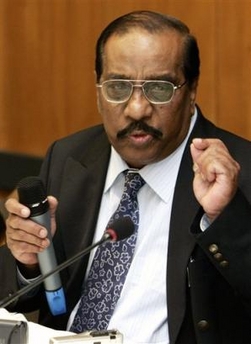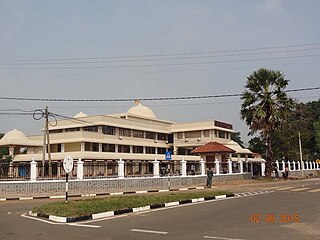
The Liberation Tigers of Tamil Eelam was a Tamil militant organization, that was based in the northern and eastern Sri Lanka. The LTTE fought to create an independent Tamil state called Tamil Eelam in the northeast of the island in response to violent persecution and discriminatory policies against Sri Lankan Tamils by the Sinhalese-dominated Sri Lankan Government.

The Sri Lankan civil war was a civil war fought in Sri Lanka from 1983 to 2009. Beginning on 23 July 1983, it was an intermittent insurgency against the government by the Liberation Tigers of Tamil Eelam led by Velupillai Prabhakaran. The LTTE fought to create an independent Tamil state called Tamil Eelam in the north-east of the island, due to the continuous discrimination and violent persecution against Sri Lankan Tamils by the Sinhalese-dominated Sri Lanka government.
Tamil Makkal Viduthalai Pulikal, previously known as the "Karuna Group", is a political party in Sri Lanka. It was formed by Karuna Amman, a former leader of the Liberation Tigers of Tamil Eelam, after he defected from the organization in 2004. Initially a paramilitary group that helped the Sri Lankan Government fight the Tamil Tigers, the TMVP was registered as a political party in 2007. Under deputy leader Pillayan, they contested their first provincial elections in 2008, winning a majority in the Eastern Provincial Council. Members of the TMVP continue to carry arms under the auspices of the Sri Lankan government, which they claim is for their own safety from the Tamil Tigers, who carry out repeated attacks against them. The group is believed to be working with the Sri Lankan Army. They have been accused of human rights violation by local and international human rights organization.

The Sea Tigers was the naval wing of the Liberation Tigers of Tamil Eelam (LTTE) during the Sri Lankan Civil War. It was founded in 1984. The Sea Tigers had a number of small but effective suicide bomber vessels. During its existence it had gained a reputation as a capable adversary for the Sri Lankan Navy. During the civil war, the Sea Tigers had sunk at least 29 Sri Lankan small inshore patrol boats, 20 Dvora-class fast patrol boats, 3 gunboats, 2 Large surveillance command ships, and one freighter.

Anton Balasingham Stanislaus was a Sri Lankan Tamil journalist, rebel and chief political strategist and chief negotiator for the Liberation Tigers of Tamil Eelam, a separatist Tamil militant organisation in Sri Lanka.

Mullaitivu is the main town of Mullaitivu District, situated on the north-eastern coast of Northern Province, Sri Lanka. A largely fishing settlement, the town in the early twentieth century grew as an anchoring harbour of the small sailing vessels transporting goods between Colombo and Jaffna. The town has a District Secretary's office, many other government institutions and schools located in and around the area.

The Vaharai bombing is a disputed event in the Sri Lankan civil war. It occurred on November 7, 2006 when, according to survivors of the incident interviewed by Reuters, the Liberation Tigers of Tamil Eelam fired artillery at Sri Lankan military personnel from near a school where minority Sri Lankan Tamil refugees displaced by the current phase of the Sri Lankan civil war had taken shelter. The Sri Lankan Army returned fire and around 45 civilians were killed. Over 100 were injured and admitted to the local hospitals. However, people who were interviewed by Human Rights Watch claimed that the LTTE did not fire artillery. Further, the rebel LTTE denies firing artillery from close to the school. The incident occurred at around 11.35 a.m close to Kathiraveli, a coastal village in Vaharai peninsula of the Batticaloa district in eastern Sri Lanka.

The Chencholai bombing took place on August 14, 2006 when the Sri Lankan Air Force bombed what it said was a rebel Liberation Tigers of Tamil Eelam (LTTE) training camp, killing 61 girls aged 16 to 18. The LTTE, UNICEF, the Sri Lanka Monitoring Mission and UTHR all said those in the compound were not LTTE cadres.
The Kebithigollewa massacre occurred on 15 June 2006 when 60 civilians were killed by an Claymore mine attack on a bus. The U.S and the SLMM claimed that LTTE was the perpetrator.

The Padahuthurai bombing or Illuppaikadavai bombing happened on January 2, 2007, when the Sri Lanka Air Force bombed what they claimed to be rebel LTTE naval base in Illuppaikadavai in Northern Sri Lanka. Sri Lanka Monitoring Mission, the local Roman Catholic bishop, and the LTTE claimed 15 minority Sri Lankan Tamils, including women and children, were killed and 35 injured due to the bombing.
The 2006 Trincomalee Massacre of NGO Workers, also known as the Muttur Massacre, took place on 4 or 5 August 2006, when 17 employees of the French INGO Action Against Hunger were shot at close range in the city of Muttur, Sri Lanka, close to Trincomalee. The victims included sixteen minority Sri Lankan Tamils and one Sri Lankan Muslim.

Eelam War IV is the name given to the fourth and final phase of armed conflict between the Sri Lankan military and the separatist Liberation Tigers of Tamil Eelam (LTTE). Renewed hostilities began on the 26 July 2006, when Sri Lanka Air Force fighter jets bombed several LTTE camps around Mavil Aru anicut. The government's casus belli was that the LTTE had cut off the water supply to surrounding paddy fields in the area. Shutting down the sluice gates of the Mavil Aru on July 21 depriving the water to over 15,000 people - Sinhalese and Muslim settlers under Sri Lankan state-sponsored colonisation schemes in Trincomalee district. They were denied of water for drinking and also cultivating over 30,000 acres of paddy and other crops. The fighting resumed after a four-year ceasefire between the Government of Sri Lanka (GoSL) and LTTE. Continued fighting led to several territorial gains for the Sri Lankan Army, including the capture of Sampur, Vakarai and other parts of the east. The war took on an added dimension when the LTTE Air Tigers bombed Katunayake airbase on March 26, 2007, the first rebel air attack without external assistance in history.

The Eastern Theatre of Eelam War IV started in the Eastern province of Sri Lanka on July 21, 2006, when the LTTE cut off the water supply to rice fields in eastern Trincomalee district. The government claimed total control of the Eastern province after capturing Thoppigala on July 11, 2007, after nearly a year of fighting. Major battles took place at Sampoor, Vakarai, Kanchikudicharu, Kokkadichloai and Thoppigala. Military and civilian deaths were relatively low on both sides. Government forces captured much military hardware from the LTTE during the conflict. The civilians managed to flee the combat zones, and this reduced civilian casualties, while swelling the number of internally displaced people (IDP). The world health organization (WHO) estimated ~200,300 IDPs, and claims that significant progress occurred in resettling them. The LTTE vowed to attack Sri Lanka's military and economic targets across the country to retaliate for the capture of the Eastern province from them. This was stated by the leader of the LTTE's political wing, S.P. Thamilchelvan, in a statement to Associated Press on July 12, 2007.
The Secretariat for Coordinating the Peace Process (SCOPP) was established on 6 February 2002 by the Government of Sri Lanka (GOSL) to facilitate the peace process during a break in hostilities in the Sri Lankan Civil War. Heading the Secretariat were Bernard Goonetilleke (2002–2004), Dr. Jayantha Dhanapala (2004–2005), Dr. Palitha Kohona (2006–2007) and Prof. Rajiva Wijesinha (2007–2009). On 19 May 2009, Mahinda Rajapakse, then President of Sri Lanka, declared the end of the insurgency and the defeat of the Liberation Tigers of Tamil Eelam (LTTE), and the SCOPP was shut down on 31 July 2009.
The Northern Theatre of Eelam War IV refers to the fighting that took place in the northern province of Sri Lanka between July 2006 and May 18, 2009.
The Battle of Sampur was fought in 2006 for the town of Sampur.

The Sri Lanka Armed Forces is the overall unified military of the Democratic Socialist Republic of Sri Lanka encompassing the Sri Lanka Army, the Sri Lanka Navy, and the Sri Lanka Air Force; they are governed by the Ministry of Defence (MoD). The three services have around 346,700 active personnel; conscription has never been imposed in Sri Lanka. As of 2021 it is the 14th largest military in the world, with 1.46% of the Sri Lankan population actively serving.

Denmark – Sri Lanka relations refers to the current and historical relations between Denmark and Sri Lanka. Denmark is represented in Sri Lanka through its embassy in New Delhi, India. Sri Lanka is represented in Denmark through its embassy Oslo, Norway. Bilateral relations are described as warm for a long time. About 13,000 immigrants from Sri Lanka live in Denmark. President of Sri Lanka Chandrika Bandaranaike Kumaratunga visited Denmark in March 1995.
Divisions of the Liberation Tigers of Tamil Eelam refers to the military, intelligence and overseas divisions the Liberation Tigers of Tamil Eelam (LTTE). Most of these divisions were destroyed during the Eelam War IV, and only parts of the intelligence and financing divisions remain overseas.












